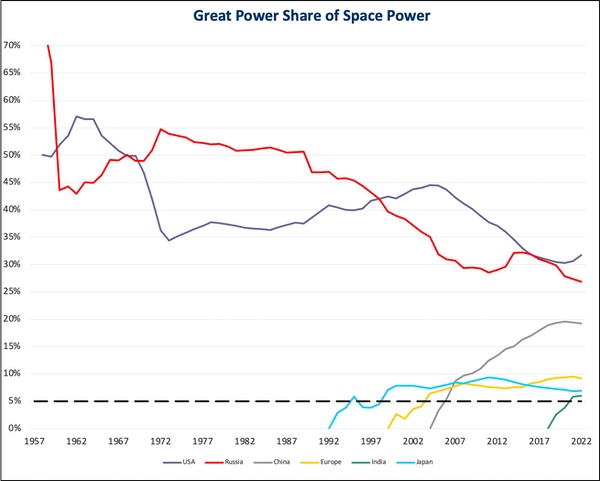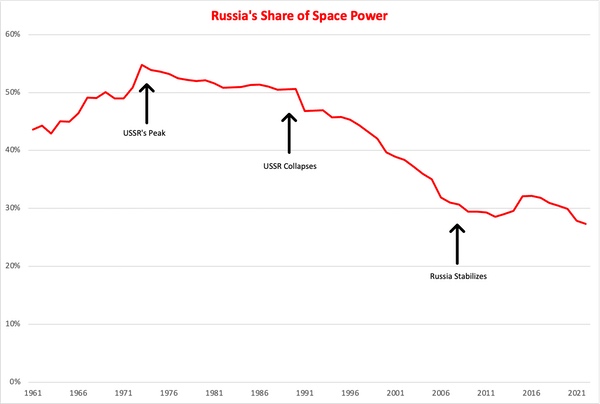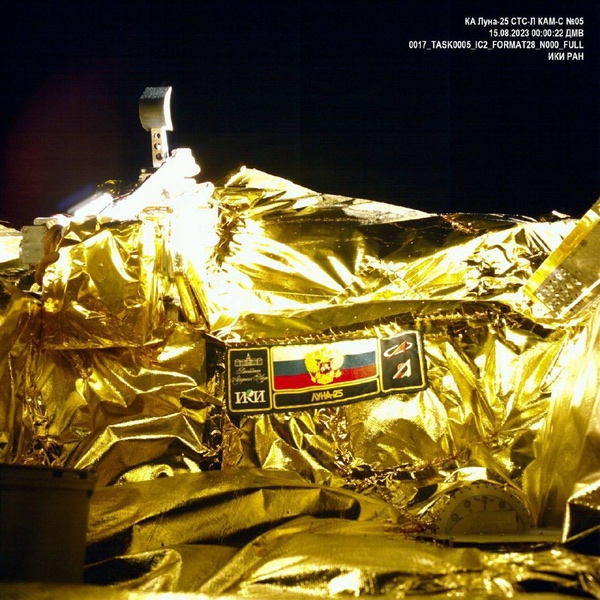Despite the Luna-25 failure, Russia is not a declining space powerby Daniel Duchaine
|
| In the last decade, Russia has rebuilt and reinvested in its military space capabilities and has stabilized its share of space power. |
Major news outlets suggest that Russia has been in decline in space since the fall of the Soviet Union. The New York Post stated of Luna-25: “Its failure highlighted the intense decline of Russia’s authority over space since the days of the Cold War, when Moscow was the first to launch a satellite — Sputnik 1 — to orbit the Earth.” Reuters and the New York Times echoed with similar sentiments. Reuters stated: “The failure underscored the decline of Russia's space power since the glory days of Cold War competition when Moscow was the first to launch a satellite to orbit the Earth — Sputnik 1, in 1957 — and Soviet cosmonaut Yuri Gagarin became the first man to travel into space in 1961.”
With the common wisdom seeming to be that Russia is a great power in decline in space, let us consider a more systematic understanding of Russia’s space power.
 |
The Space Power Index
The Space Power Index is an index I created to try to quantitatively measure how much power a state holds in the space domain, relative to the system as a whole (see “Is China’s rise in space over? Indexing space power for the next space age”, The Space Review, July 31, 2023.) It is based on cumulative objects launched into orbit, scientific achievements, and space military capabilities. While I considered every state with a space program, only those that cracked 5% of total space power at some point in their history are considered great powers and are included in the system.
Cumulative Orbital Launches: I chose cumulative orbital launches as an input for a number of reasons. First, it shows that a state has the technological capacity to design, build, and deploy space technology. Second, it shows that the state has a high industrial capability, required for launching large numbers of satellites. Third, it is a reliable and easy to find datasets that are consistent for all states.
Scientific Achievements: This input is a binary for a variety of space scientific achievements. When a state accomplished one of these achievements, it gained 1 unit of the input. Scientific achievements show that the state is able to overcome significant scientific and technological challenges.
Military Capabilities: Similar to Scientific Achievement, this index is based on whether a state is thought to have certain military capabilities in space like direct ascent ASAT or electronic warfare capabilities.
This index may seem subjective, and it is. Great power status is inherently subjective. It depends on whether the other international systems consider your country as a great power. India probably wasn’t objectively a more powerful country the day before it launched a direct ascent anti-satellite (ASAT) weapon, but doing so got the attention of the rest of the system. So, the goal for this index is to track things that would make a country seem powerful. You can check my data as a Microsoft Excel sheet here.
 |
History of Russian space power
Dominance: From the beginning of the space age until the 1990s, Russia, as part of the USSR, dominated the space system. From launching the Salyut 1 to introducing the first Mars probe, the USSR was an unrivaled force in space, demonstrating not just scientific, but also formidable military capabilities.
With the launch of the first space station: Salyut 1, the First Mars impactor, the First Mars probe, and the development of counter space capabilities in the form of Almaz, 1971 was the peak of the Soviet share of Space Power (not including the years when the USSR was the only space power). In the 1970s and ’80s, the US caught up in scientific achievements, but the USSR continued to lead in objects launched, military capabilities, and maintain its place as the dominant space power.
| Momentary failures should not dictate our understanding of a nation’s overall capabilities. We should not underestimate Russia’s capabilities. |
Decline: From 1990 to 2012, Russia actually was a space power in decline. Key space infrastructure, primarily developed during the Cold War for missile warning and defense, began to crumble. Financial constraints crippled Russia's space endeavors, leading to fewer payloads being launched and a pause in achieving new scientific milestones. The biggest factor, however, was the decline in Russia military capabilities, namely its space situational awareness (SSA) capabilities. From the Secure World Foundation’s Global Counterspace Capabilities Report: “Russian SSA capabilities date to the Cold War and leverage significant infrastructure originally developed for missile warning and missile defense. Although some of these capabilities atrophied after the fall of the Soviet Union.” In the mid-1990s, the US surpassed Russia as the dominant space power, and the entrances of Europe, China, and Japan into the system further ate into Russia’s share of space power.
2010–2022: Contrary to prevailing opinions, the past decade has been a period of stabilization for Russia. Its share of space power was on the rise in the mid-2010s, though fittingly, this was slowed by India’s entrance into the system. Russia’s share of space power in 2022, 26.7%, is basically the same as it was in 2007, 26.8%.
This past decade Russia has steadily increased its share of objects launched, maintained its share of scientific achievements, but most importantly has reestablished its lead as the preeminent military space power. This is due to Russia’s revitalization of its Soviet-era military space systems led by the new Russian Aerospace Forces, created in 2015. Russia restarted rendezvous and proximity operations (RPO) testing in both low Earth orbit and geosynchronous orbit, signaling a potential co-orbital ASAT program in the works. Russia’s Luch satellite maneuvered and lingered near an Intelsat satellite for about 145 days, playing a “cat and mouse game.” Additionally, Russia has also tested an ASAT weapon nearly every year from 2014 to 2021. This includes direct-ascent ASAT weapons like the notorious 2019 and 2021 debris-generating tests. Since the war in Ukraine began in 2022, Russia demonstrated cyber capabilities, hacking a Viasat ground station and jamming capabilities throughout Eastern Europe.
In the light of the Space Power Index, a different picture of Russian space power emerges. While Russia’s scientific space sector has plateaued, Russia’s share of launches increased gradually and Russia’s share of military capabilities increased this decade.
Momentary failures should not dictate our understanding of a nation’s overall capabilities. We should not underestimate Russia’s capabilities. Luna-25’s demise is not emblematic of Russia's space trajectory, and it should not distract from the reality that Russia is rebuilding its military space systems, stabilizing its space power, and remains a capable and potentially dangerous space power with a highly capable space military.
Note: we are using a new commenting system, which may require you to create a new account.
